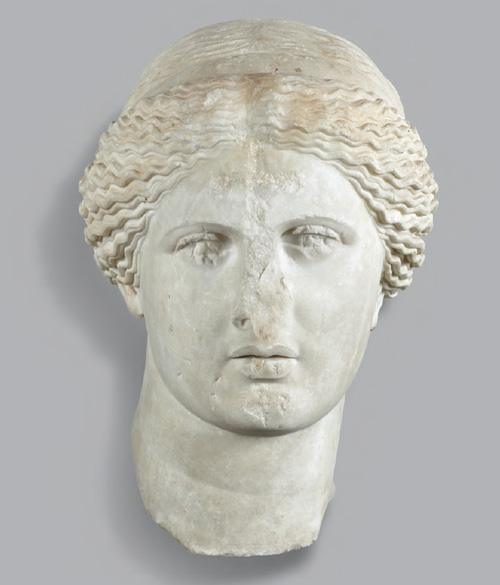The vibrant and complex life of the Eastern Mediterranean during a time of reinvention and renewal will be the subject of a major new exhibition at the Onassis Cultural Center in Midtown Manhattan. On view from December 7, 2011 through May 14, 2012, Transition to Christianity: Art of Late Antiquity, 3rd – 7th Century A.D. will bring together more than 170 exceptional objects on loan from Greek museums, as well as museums in Cyprus and the United States. Incorporating many outstanding works of art that have never before been seen outside Greece, as well as recently discovered works that are being exhibited for the first time anywhere, Transition to Christianity reveals a period of extraordinary and perhaps unexpected creativity in the Greek world of Late Antiquity.

The extraordinary objects in the exhibition represent a wide range of media and functions: mosaics, paintings, sculptures, architectural elements, inscriptions, coins, liturgical objects, jewelry and domestic furnishings. Together, they reveal the creative ferment of the world of Late Antiquity, when a new society, religion and material culture were gradually replacing the old.
According to Peter Brown, Transition to Christianity reflects a change in recent decades in the way scholars view the period when the sun was setting on the Western Roman Empire. “There was life after the third century; and this life came to bear the name of ’Late Antiquity,’” he writes. “This exhibition is devoted, in large part, to showing the strange and colorful life of an age which had once been consigned to the shadows, as an age of death and gloom…. Here was an other story, told under an other, more peaceful, eastern sky: the preparation, throughout the territories still ruled from Constantinople by Roman emperors, of a Byzantine civilization that would last for a further millennium.”

Transition to Christianity will reveal this story through seven thematic sections:
The first section, The End of Antiquity? Cultural and Religious Interactions, bears witness to the survival of the ancient Greek and Roman forms of worship and the mystery cults in the 3rd and 4th centuries, and to Christianity’s rise within this cultural milieu. Statues from house shrines document the continuation of paganism well into the 6th century, when it survived as part of the culture of the social elite. Meanwhile, Christianity adapted and incorporated existing artistic forms and subjects. The image of the philosopher, for example, with his profound gaze and intense features, became the model that Christians used to depict the apostles.
The second section, Christianity on the Rise: From Recognition to Authority, surveys the effects of Emperor Constantine the Great’s recognition of Christianity and policy of building magnificent churches in the empire’s great urban centers. Images on coins testify to the merger of imperial and Christian imagery. In this medium, the Christian emperors borrowed imagery from past examples, redeployed them for a new message of Christian triumph.

The fourth section, Daily Life, presents objects relating to the public entertainments in the Hippodrome (which supplanted the banned Olympic games); wedding rings, which reflect the gradual Christianization of the institution of marriage; and ornaments that testify to the continuing desire for personal beauty in a society that was turning more and more toward the other world. A variety of amulets and charms with magic symbols believed to ward off demons and protect against the evil eye show the prevalence of syncretic, popular beliefs—although the symbol of the cross or the image of a guardian saint became increasingly ubiquitous in ornamentation used for personal protection.
After Christians were granted the freedom to worship openly, churches rose across the Empire. In the section Early Christian Worship, architectural elements and examples of church furniture demonstrate appropriation and modification of old forms for new religious needs. Together with adaptation of old building types for new functions−the basilica (based on the Roman secular building type), and the centrally planned church (based on late Roman mausoleums)−these objects collectively demonstrate the process of transformation.

Finally, The Genesis of Christian Art will examine the emergence of Christian visual language in Late Antiquity. It is in the funerary context that most evidence of the earliest Christian art has been preserved. The symbols that held exclusive meaning for the new religion—the cross, the Chi-rho and the fish—were eventually joined by a broader repertoire of figurative art. Glass, paintings, and sculpted reliefs shared motifs and iconographic formulas of pagan art, but adapted these to a new Christian context.
Christianity’s ultimate triumph over paganism led to an increasing readiness to appropriate aspects of ancient art for its own purposes. This last section will examine how certain pagan forms and ideas became integral in the new Christian art. Perhaps the most ubiquitous among pagan art forms, the portrait, was gradually replaced by its two-dimensional Christian counterpart, the icon (depicting Christ, apostles, martyrs and saints), whose representational value was commonly accompanied by miraculous powers possessed by the image itself.

“The subject of Transition to Christianity is of obvious relevance to the present day,” state Eugenia Chalkia and Anastasia Lazaridou. “Starting from the principles that nothing is born of nothing, that everything continues its momentum for a while even after it has gone, that for something to be created there must be a need for it, and for something to be snuffed out it must be redundant, we can understand that all things, tangible or otherwise, are products of constant flux, transformation and reinvention.”
The exhibition runs from December 7, 2011 – May 14, 2012 and is jointly organized by the Onassis Foundation (USA) and the Byzantine and Christian Museum, Athens. The Onassis Cultural Center is open to the public Monday through Saturday, 10 am to 6 pm, except Christmas and New Year’s Day. Admission is free.
Source: The Onassis Foundation [December 03, 2011]
VIA «Transition to Christianity: Art of Late Antiquity, Third to Seventh Century AD»